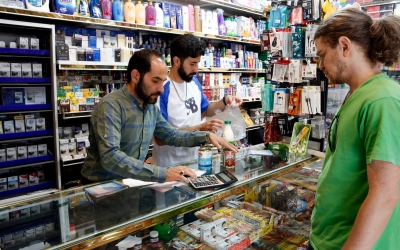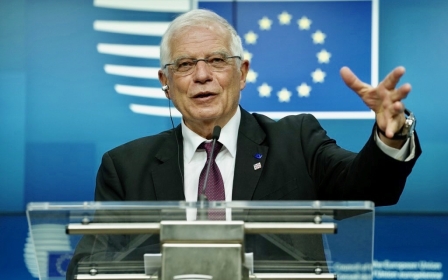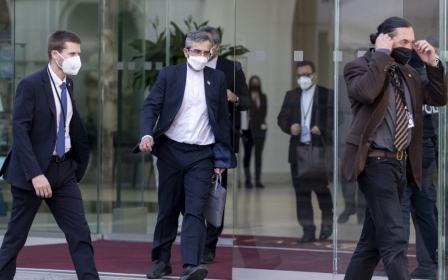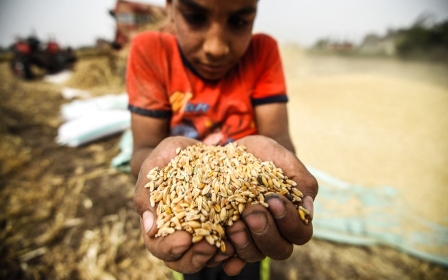'Economic surgery is killing us': Iranians complain as subsidies slashed on basic foods

As Iranians gathered on 21 March for the Persian New Year of Nowruz, many reflected on a year of suffering and economic hardship. Little did they know that worse was soon to come.
Last month, Iran’s hardline government declared that it had decided to cut and end subsidies for wheat and flour, calling it necessary “economic surgery”.
'Falafel was a kind of sandwich that benefited both the customer and the restaurant, but with the new situation, it is not affordable for anyone'
- sandwich shop owner, Tehran
This has led to unprecedented price rises in many essential foods, including pasta, angering millions.
The increase in the price of pasta is significant because Persian rice, a staple for Iranians, has turned into a luxury food for the poor and even the middle class.
Today, a 10kg bag of rice costs more than one million tomans ($33). With prices like these, pasta became a quick substitute for struggling Iranians for a while. But the subsidy cuts have caused a 169-percent surge in pasta prices.
New MEE newsletter: Jerusalem Dispatch
Sign up to get the latest insights and analysis on Israel-Palestine, alongside Turkey Unpacked and other MEE newsletters
Speaking to Middle East Eye on condition of anonymity, fearing government repression, a veteran economic journalist said there has been a clear decline in workers' livelihoods since the beginning of the year.
“Today we see that meat consumption per capita has fallen sharply and workers have been forced to turn to hydrates and starches to just feel full,” the journalist said.
“Now, with the price of wheat and pasta skyrocketing, the … feeling of being full is being taken away from workers.”
The government argues that the price hike is because of the global wheat crisis sparked by the Russian invasion of Ukraine. Both countries are among the biggest producers and exporters of wheat and corn, as well as cooking oil.
According to the government’s official website, President Ebrahim Raisi’s administration had to cut wheat and flour subsidies as many middlemen were buying subsidised flour from local industrial businesses with a surplus to smuggle abroad and make a huge profit.
Either way, the subsidy cuts were unexpected and led to a short-term scarcity of pasta in stores as people rushed to buy it at the old prices.
Online the hashtags “pasta” and “pastagate” have trended, as Iranians bemoan the surge in prices and shortages.
'If Raisi’s government had access to its oil income, it wouldn’t have resorted to cutting the subsidies'
- Veteran economic journalist
One person tweeting under the name Golnesa ridiculed the government’s arguments, saying: “Did you know that [eating] pasta results in bloating and increased flatulence, and this is one of the main reasons for ozone depletion.”
Soroush, a delivery man, told MEE that he has had to cut out certain foods repeatedly in recent years.
“I have to eat lunch outside at noon because of my job. Until four years ago, I was able to buy chicken or kebabs. When Trump decided to exit the nuclear deal, we witnessed an economic shock. This made me ignore chicken and kebab and purchase pasta or even cookies instead,” he said.
“Right now, I can’t even have these, as both pasta and cookies’ prices have skyrocketed. I don’t what the hell I should do.”
A veteran economic journalist told MEE: “Raisi’s government is irritating people. During the past months, they were always bragging about bypassing oil sanctions and getting its money directly into Iran’s bank account. But it is crystal clear to everyone that these were big lies.
“If Raisi’s government had access to its oil income, it wouldn’t have resorted to cutting the subsidies. This move shows they don’t have enough money in their pockets to allocate budget for the subsidies.”
Falafel hit too
Another staple for working-class Iranians is also badly affected: falafel sandwiches.
Previously, a falafel sandwich would cost around 15,000 tomans ($0.50)
But Ahmadi Shahrivar, the chairman of the Tehran Restaurants Association, told a local outlet that baguette prices have doubled. He added that this will cause a 15 percent surge in sandwich prices.
“With this price hike, cheap sandwiches such as falafel, which were usually popular among the low-income groups, have turned into expensive sandwiches,” said Shahrivar.
Meanwhile, the government has also cut cooking oil subsidies, creating more trouble for sandwich shops and low-income people.
Mehran, a sandwich shop owner in the centre of Tehran, told MEE: “Falafel was a kind of sandwich that benefited both the customer and the restaurant, but with the new situation, it is not affordable for anyone. That’s why I have decided not to sell falafel anymore.”
He added: “I could increase its price after the flour subsidies ending, but now with cooking oil subsidies gone too, I guess I have to double the price again and that wouldn’t still cover my spending.”
Ahmad Reza, a taxi driver who works 10 hours a day, told MEE: “This is not an economic surgery! It is called choking people. What kind of surgery is this that people can’t even have cheap food. Surgery usually makes people survive and feel great again, but the government’s economic surgery is killing us.”
In response to the outcry, the government said it will provide the majority of people with 300,000-400,000 tomans per month to compensate for cutting the subsidies, but many say the equivalent of $13 is nothing compared to the rising prices.
Protests erupt
The anger is beginning to be felt on the street.
Various cities and provinces in Iran, including Shahrekord, Chaharmahal Bakhtiari and Isfahan, are witnessing protests, where demonstrators are chanting slogans against the government’s policies. Violent police crackdowns have followed.
While the protests have not become widespread, a lawmaker confirmed that at least one person has been killed in the demonstrations in Dezfoul, a city in the southwestern province of Khouzestan. However, he later denied such a report.
Meanwhile, internet disruption continues, especially for mobile phones in different parts of Iran, including many cities in Khuzestan province.
An economics professor, speaking on condition of anonymity, predicted more prices to rise.
"As the price of staples rises sharply, we should expect a similar increase in the price of related and complementary food items, as well as those whose production chain is connected to these goods,” they said.
“Is it possible for the price of baguette to increase many times over but the price of sandwiches to remain the same? Or the price of flour and oil to increase but the price of cookies not to change? When the prices of these staples increase, people expect their salaries to increase as well, so the prices of various services also would go up soon.”
As for the monthly stipend promised by the government, the professor said: “Paying monthly stipends has always been a problem in Iran, a country that is always struggling with inflation. Rising inflation and economic shocks in the blink of an eye would greatly reduce the purchasing power of the monthly aid.
“The result of this policy is nothing but the continuation of the brutal cycle of the inflationary stagnation in the country and more people going below the absolute poverty line,” the professor added.
Middle East Eye delivers independent and unrivalled coverage and analysis of the Middle East, North Africa and beyond. To learn more about republishing this content and the associated fees, please fill out this form. More about MEE can be found here.






